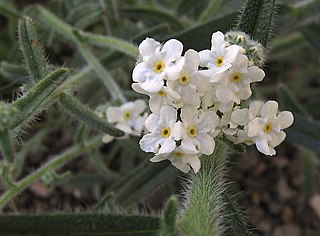
Cryptantha is a genus of flowering plants in the borage family, Boraginaceae. They are known commonly as cat's eyes and popcorn flowers. They are distributed throughout western North America and western South America, but they are absent from the regions in between.

Monarda fistulosa, the wild bergamot or bee balm, is a wildflower in the mint family Lamiaceae, widespread and abundant as a native plant in much of North America. This plant, with showy summer-blooming pink to lavender flowers, is often used as a honey plant, medicinal plant, and garden ornamental. The species is quite variable, and several subspecies or varieties have been recognized within it.

Gentiana alba is a herbaceous species of flowering plant in the Gentian family Gentianaceae, producing yellowish-white colored flowers from thick white taproots. It is native to North America from Manitoba through Ontario in the north, south to Oklahoma, Arkansas and North Carolina, and it is listed as rare, endangered, threatened or extirpated in parts of this range.
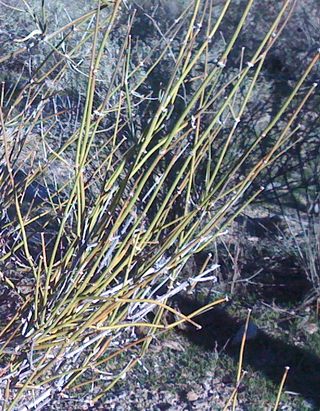
Ephedra fasciculata is a species of plant in the Ephedraceae family. Common names are Arizona ephedra, Arizona jointfir, and desert Mormon-tea.
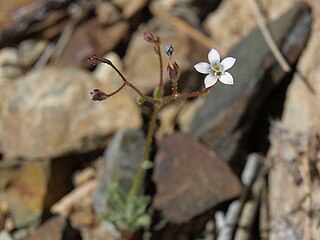
Gilia clokeyi is a species of flowering plant in the phlox family known by the common name Clokey's gilia. It is native to the south-western United States from California to Colorado, where it grows in desert and other habitat.

Glossopetalon spinescens, syn. Forsellesia spinescens, is a species of flowering shrub in the family Crossosomataceae known by the common names greasebush, spiny greasebush, Nevada greasewood and spring greasebush.
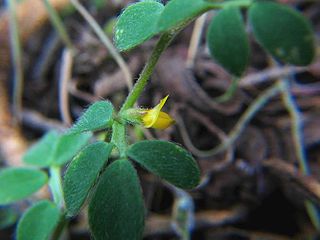
Acmispon wrangelianus is a species of legume native to California and Oregon in the southwestern United States. It is known by the common names Chilean bird's-foot trefoil and Chile lotus. Despite its common name, it is not from Chile. It can be found in many types of habitat, including disturbed areas. This is a hairy, prostrate annual herb. Its slender branches are lined with leaves each made of generally four small leaflets. The inflorescence is composed of a solitary yellow pealike flower around a centimeter wide. The fruit is a legume pod one to two centimeters long.

Cirsium eatonii, commonly known as Eaton's thistle or mountaintop thistle, is a North American species of flowering plants in the family Asteraceae.

Clematis crispa is a species of flowering plant in the buttercup family known by the common name swamp leatherflower. It is found in southeastern United States.

Evolvulus nuttallianus is a species of flowering plant in the morning-glory family known by the common name shaggy dwarf morning-glory. It is found in the central United States.

Valerianella ozarkana is a species of flowering plant in the honeysuckle family known by the common name Palmer's cornsalad. It is found in Arkansas and Oklahoma in the United States.

Baptisia nuttalliana is a species of flowering plant in the legume family known by the common name Nuttall's wild indigo. It is found in the south-central United States.

Hypericum prolificum, known as shrubby St. John's wort, is a deciduous shrub in the genus Hypericum. It was named for its "prolific" number of stamens.
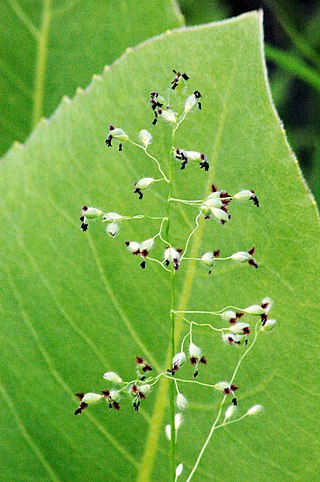
Dichanthelium leibergii, known as variously as Leiberg's panicum, Leiberg's panicgrass, Leiberg's rosette grass, and prairie panic grass is a species of grass native to North America. It was named for its discoverer, John Bernhard Leiberg (1853-1913), a Swedish-born American botanist active in the western United States.
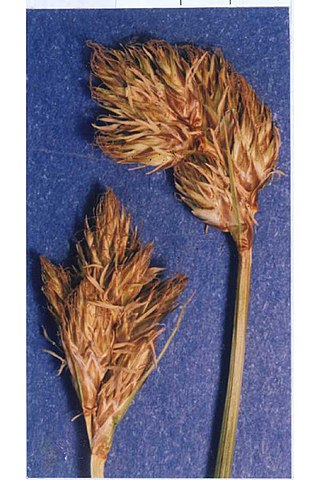
Carex arapahoensis, known as Arapaho sedge, is a species of sedge endemic to the western United States. It is found only in Colorado and Utah in alpine and subalpine habitat.
Ira Waddell Clokey (1878-1950) was an American mining engineer and botanist active in the western United States. He first studied at the University of Illinois, then moved to Harvard University, graduating with a Bachelor of Science in mining engineering in 1903. From 1904 to 1915, Clokey worked as a mining engineer in Mexico. In his spare time he collected plant specimens for his personal herbarium, which, however, was almost completely destroyed during a fire in 1912. In 1921, Clokey completed a Master of Science in plant pathology from Iowa State University.

Mertensia lanceolata, known as prairie bluebells, narrow-leaved languid lady, lance-leaved bluebells, and lance-leaved lungwort is a species of flowering plant native to western North America. A herbaceous perennial it has blue-green leaves alternately arranged on its smooth flowering stalk. Its flower buds are pink-purple and become more blue as they open. Accepted varieties include:
Silene clokeyi, known as Clokey's catchfly, is a species of flowering plant in the pink family. It is native to western North America.
Solanum clokeyi, known as Clokey's nightshade, Island nightshade, or Santa Cruz Island nightshade, is a species of flowering plant in the nightshade family endemic to California, United States. It occurs in southeastern California, including the Channel Islands and Santa Catalina Island. The name honors American botanist Ira Waddell Clokey. It is sometimes treated as a synonym or variety of Solanum wallacei.
















